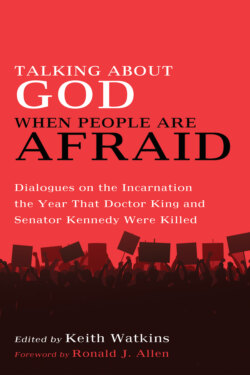Talking About God When People Are Afraid

Реклама. ООО «ЛитРес», ИНН: 7719571260.
Оглавление
Группа авторов. Talking About God When People Are Afraid
Talking About God When People Are Afraid
Table of Contents
Foreword
Acknowledgments
A Challenging Time to Preach about God
The Advent Dialogues
The Lenten Dialogues
Second Thoughts Two Generations Later
The Enduring Legacy
Advent 1: Bound
Advent 2: Doing Your Own Thing
Advent 3: Getting Your History Straight
Advent 4: Entering the Main Stream
Advent 5: Delivered
Lent 1: In Sight of the City He Wept
Lent 2: His Hand with Mine on the Table
Lent 3: In Anguish of Spirit He Prayed
Lent 4: His Teaching Is Causing Dissatisfaction
Lent 5: Do Not Weep for Me, Weep for Yourselves and Your Children
Lent 6: Why Search Among the Dead for One Who Lives?
Bibliography
Отрывок из книги
Dialogues on the Incarnation the Year That Doctor King and Senator Kennedy Were Killed
Edited by Keith Watkins
.....
Going further, one of the important themes in the emerging postmodern culture in both the wider world and in theology and the church is boundary-crossing, or transgression. While the expert is still respected, there is a growing sense that experts often have limited perspectives, and that people outside of expert status often have important things to contribute to discussion. From this point of view, ministers should no longer think of themselves as the sources of theological insight for preaching. Indeed, increasing numbers of clergy are making use of sermon feed-forward groups in which ministers meet with lay people as part of sermon preparation.3 It is a short small step from clergy and laity thinking together about the sermon in the study to clergy and laity speaking with one another in the pulpit.
To be sure, everything in this volume should not be a spark for preaching in the present. Most of these sermons lasted about half an hour—one or two perhaps as long as forty minutes. Few congregations in the historic denominations today are prepared to make this kind of investment in the sermon. Moreover, the sermons are written in a style that is as much literary as oral-aural. Indeed, some of the sermons are almost essay-like style in a way that would sound stilted in the pulpit today. While the sermons are exceptional in theological penetration, the preachers seldom address listeners directly, in the way that would be typical of active dialogue today. Indeed, I am struck by how often the sermons are almost third-person in their rhetorical orientation.
.....